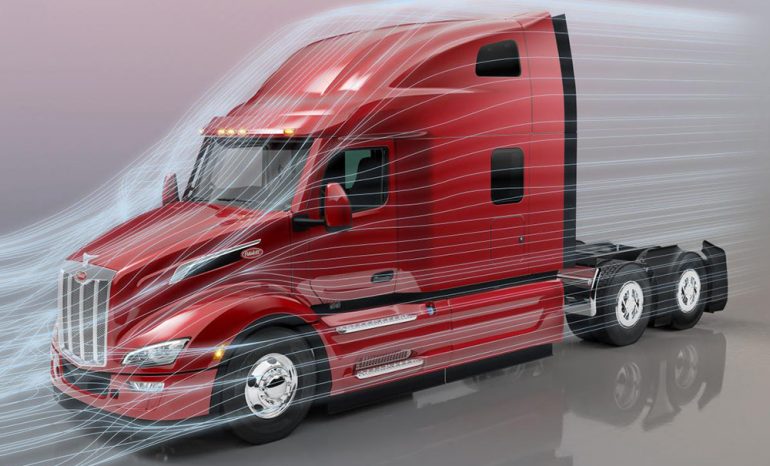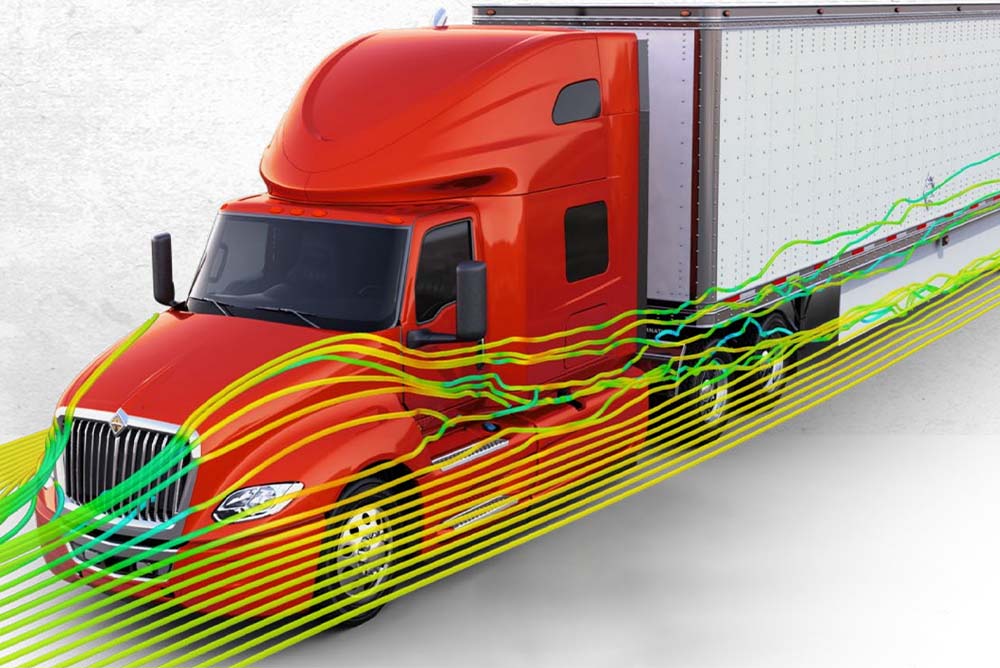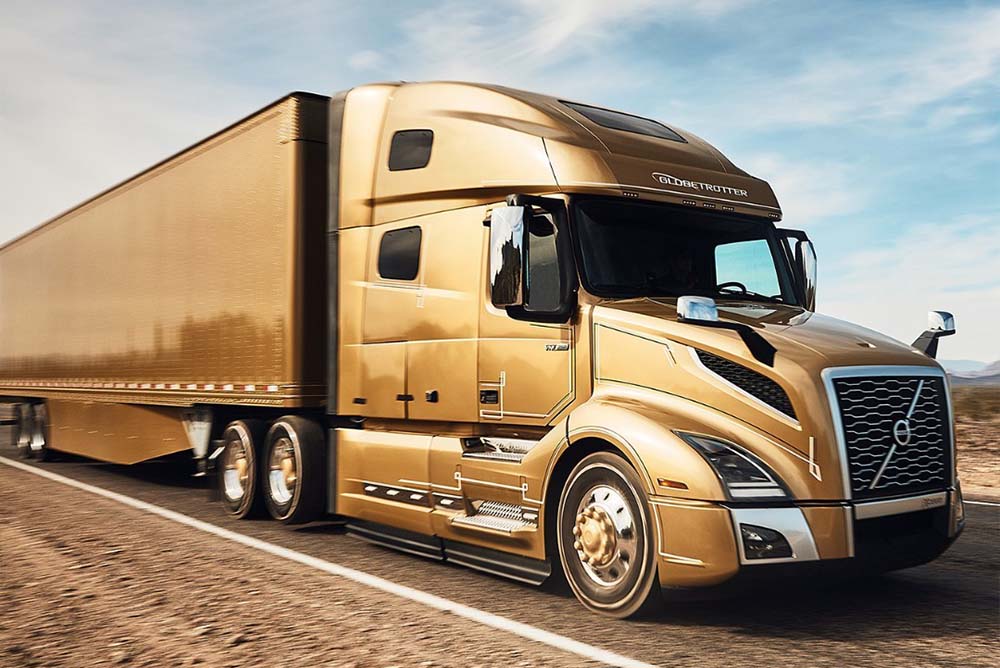Fuel is the biggest budget expense in our industry, which is why we always strive to cut any unnecessary fuel spending. Semi-truck aerodynamics are of great importance here since aerodynamic drag can increase fuel consumption significantly. A truck traveling at highway speeds uses over half of its energy combating the drag, and more energy means more fuel. Utilizing the right devices for improving the truck’s aerodynamics can save up to 12% in fuel spending.
In this article, we’re going to explain the basics of semi-truck aerodynamics and present the ways in which both the manufacturing companies and owner operators can reduce the impact of drag.
Featured image source: Peterbilt
How Do Semi-Truck Aerodynamics Work?
Every moving vehicle is facing aerodynamic drag – a force that works against it as a result of the air colliding with the vehicle’s surface. The laws of aerodynamics are the same for every type of vehicle, but semi-trucks have more surfaces pressing against the air than most. The drag slows down the truck, which then needs more power to maintain the speed.
There are two types of drag that affect the truck – skin friction and pressure. Pressure is created by the front-facing surfaces, so the truck areas that are most exposed to it are the front of the tractor and the gap between the tractor and the trail, i.e. the front of the trailer.
Skin friction is created when air moves across a rough surface. The air particles in the layers closest to the surface of a truck create friction that slows down the rig. Although this type of drag affects trucks, its impact is minimal.

Source: Freightliner Trucks
How Do Truck Manufacturers Deal with the Drag?
Truck manufacturing companies are constantly trying to improve the aerodynamics of their models. This includes both optimizing the mechanics and shape of the trucks, as well as coming up with attachments that can be added for better performance.
The most recent alterations include:
- Improving the tractor design. This means a more aerodynamic shape of the tractor itself, but also an optimized design of bumper valances, antennas, chassis configurations, side mirrors, and roof fairings.
- Reducing the gap between the tractor and the trailer. Bigger gap results in more pressure drag, so manufacturers are trying to make the space shorter with every new model. They are also perfecting cab extender fairings and adding airtabs to the body of the tractor.
- Changing bumper shapes. Since the front of the tractor is the first point of air impact, every detail on it is important. A bumper that channels the air right sets the direction of the flow for the entire truck’s body.
8 Ways to Improve Your Semi-Truck Aerodynamics
You may not be able to change the overall body shape or mechanics of your trucks, but you can always purchase attachments that are meant to redirect the airflow and reduce drag. These add-ons will direct the air away from gaps that would create pressure drag and protect the long sides of your truck from skin friction. Reducing the drag will result in lower fuel consumption, so, with the fuel prices still rising, aerodynamic attachments can be counted among trucking essentials.
Source: International Trucks
Rear Roof Extenders
These extenders are attached to the top of the truck cabin. They compensate for the height differences between the tractor and the trailer and prevent the airflow from hitting the trailer directly.
Cab Extenders
Cab extenders are fairings that can get attached to the sides of the truck cabin, pointing back and outwards from it. Their purpose is to direct airflow away from the gap between the tractor and the trailer and prevent crosswinds from forming. If a trailer is wider than the tractor that is pulling it, cab extenders also serve to compensate for this difference and reduce direct pressure drag on the trailer. Closing the gap completely with fairings like these can save you around 2% in fuel.

Source: Volvo US
Wheel Covers
Truck wheels catch air while spinning, which disrupts the airflow and adds to the aerodynamic drag. This is caused by their large center indentations and other small crevices. Wheel covers will close off all these gaps, allowing the air to go past the tires.
Chassis Fairing
Chassis fairings are attached to the sides of the tractor, covering the fuel tank, battery box, and fenders. They will reduce wind drag in the lower areas of the cab, but they also make accessing the cassis a little harder and add to the overall weight, so some truckers avoid using them.
Source: Volvo US
Drive Wheel Fairings
These fairings close off the space between the wheels of a trailer. They prevent the airflow from hitting the tires, and, when combined with wheel covers, can reduce the drag significantly.
Rear Tail Fairings
These extensions, sometimes called boat tails, can be added to the end of your trailer. They reduce the turbulence at the back of the trailer and prevent the forming of a low-pressure vacuum. Rear tail fairings can cut the fuel costs by up to 6% if you’re driving at around 65 mph. They are made to be easily detachable for the loading/unloading of the truck.
Drive Fenders
The front fenders are among the first parts of your truck that meet the airflow. If not shaped properly, they will reduce the aerodynamics of the rig significantly.
Source: Volvo US
Vented Mudflaps
Mudflaps are usually solid since their function is to prevent dirt and debris from damaging the truck’s undercarriage. The aerodynamic version of mud flaps comes with horizontal slits that are meant to reduce drag at this part of the truck. They are not proven to make a significant difference in terms of fuel-saving, but may still contribute to improving the overall airflow to some degree.
Having all this info in mind, make sure to think about the semi-truck aerodynamics when purchasing a new truck. Also, take a walk around your current rig and locate any areas that need improvement. Investing in various fairings can save a lot on fuel costs so it will pay off very quickly. For more tips, follow us on our YouTube channel Extra Mile International Inc Trucking Company, and visit our Instagram profile @extramiletx.
Mia is a Fleet Manager and Recruiter at Extra Mile International, based in Chicago. Mia is over 5 years in the trucking industry while driving trucks for more than 3 years.








